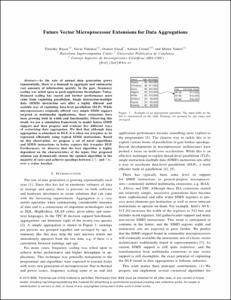Mostra el registre d'ítem simple
Future vector microprocessor extensions for data aggregations
| dc.contributor.author | Hayes, Timothy |
| dc.contributor.author | Palomar, Oscar |
| dc.contributor.author | Unsal, Osman Sabri |
| dc.contributor.author | Cristal Kestelman, Adrián |
| dc.contributor.author | Valero Cortés, Mateo |
| dc.contributor.other | Universitat Politècnica de Catalunya. Departament d'Arquitectura de Computadors |
| dc.contributor.other | Barcelona Supercomputing Center |
| dc.date.accessioned | 2016-10-10T08:29:09Z |
| dc.date.available | 2016-10-10T08:29:09Z |
| dc.date.issued | 2016 |
| dc.identifier.citation | Hayes, T., Palomar, O., Unsal, O., Cristal, A., Valero, M. Future vector microprocessor extensions for data aggregations. A: Annual International Symposium on Computer Architecture. "43rd International Symposium on Computer Architecture, ISCA 2016: 18-22 June 2016, Seoul, South Korea: proceedings". Seul: Institute of Electrical and Electronics Engineers (IEEE), 2016, p. 418-430. |
| dc.identifier.isbn | 978-1-4673-8947-1 |
| dc.identifier.uri | http://hdl.handle.net/2117/90618 |
| dc.description.abstract | As the rate of annual data generation grows exponentially, there is a demand to aggregate and summarise vast amounts of information quickly. In the past, frequency scaling was relied upon to push application throughput. Today, Dennard scaling has ceased and further performance must come from exploiting parallelism. Single instruction-multiple data (SIMD) instruction sets offer a highly efficient and scalable way of exploiting data-level parallelism (DLP). While microprocessors originally offered very simple SIMD support targeted at multimedia applications, these extensions have been growing both in width and functionality. Observing this trend, we use a simulation framework to model future SIMD support and then propose and evaluate five different ways of vectorising data aggregation. We find that although data aggregation is abundant in DLP, it is often too irregular to be expressed efficiently using typical SIMD instructions. Based on this observation, we propose a set of novel algorithms and SIMD instructions to better capture this irregular DLP. Furthermore, we discover that the best algorithm is highly dependent on the characteristics of the input. Our proposed solution can dynamically choose the optimal algorithm in the majority of cases and achieves speedups between 2.7x and 7.6x over a scalar baseline. |
| dc.description.sponsorship | The research leading to these results has received funding from the RoMoL ERC Advanced Grant GA no 321253 and is supported in part by the European Union (FEDER funds) under contract TTIN2015-65316-P. Timothy Hayes is supported by a FPU research grant from the Spanish MECD. |
| dc.format.extent | 13 p. |
| dc.language.iso | eng |
| dc.publisher | Institute of Electrical and Electronics Engineers (IEEE) |
| dc.subject | Àrees temàtiques de la UPC::Informàtica::Arquitectura de computadors |
| dc.subject.lcsh | Parallel processing (Electronic computers) |
| dc.subject.lcsh | Microprocessors |
| dc.subject.other | Registers |
| dc.subject.other | Support vector machines |
| dc.subject.other | Instruction sets |
| dc.subject.other | Data models |
| dc.title | Future vector microprocessor extensions for data aggregations |
| dc.type | Conference lecture |
| dc.subject.lemac | Processament en paral·lel (Ordinadors) |
| dc.subject.lemac | Microprocessadors |
| dc.contributor.group | Universitat Politècnica de Catalunya. CAP - Grup de Computació d'Altes Prestacions |
| dc.identifier.doi | 10.1109/ISCA.2016.44 |
| dc.description.peerreviewed | Peer Reviewed |
| dc.relation.publisherversion | http://ieeexplore.ieee.org/document/7551411/ |
| dc.rights.access | Open Access |
| local.identifier.drac | 18819475 |
| dc.description.version | Postprint (published version) |
| dc.relation.projectid | info:eu-repo/grantAgreement/EC/FP7/321253/EU/Riding on Moore's Law/ROMOL |
| dc.relation.projectid | info:eu-repo/grantAgreement/MINECO//TIN2015-65316-P/ES/COMPUTACION DE ALTAS PRESTACIONES VII/ |
| local.citation.author | Hayes, T.; Palomar, O.; Unsal, O.; Cristal, A.; Valero, M. |
| local.citation.contributor | Annual International Symposium on Computer Architecture |
| local.citation.pubplace | Seul |
| local.citation.publicationName | 43rd International Symposium on Computer Architecture, ISCA 2016: 18-22 June 2016, Seoul, South Korea: proceedings |
| local.citation.startingPage | 418 |
| local.citation.endingPage | 430 |


